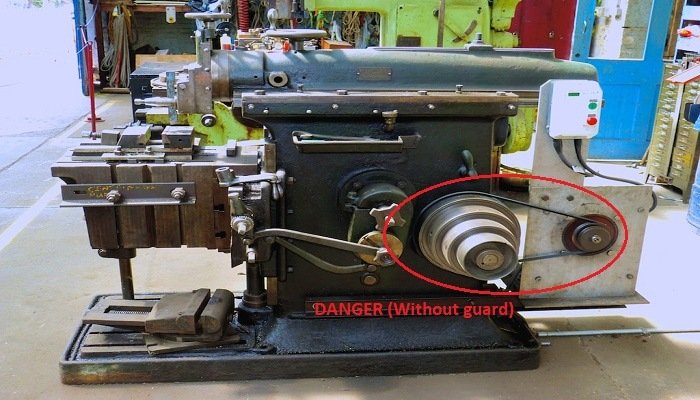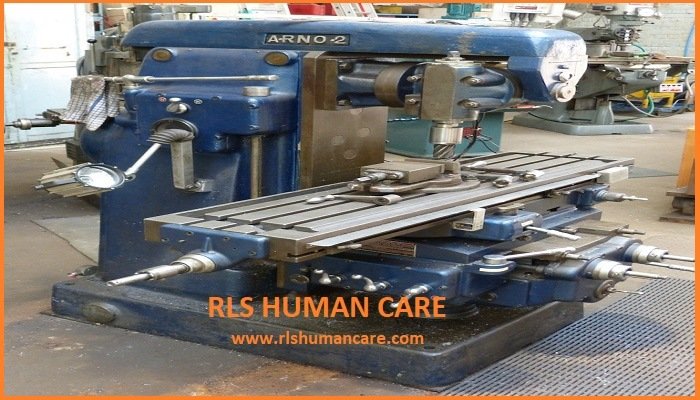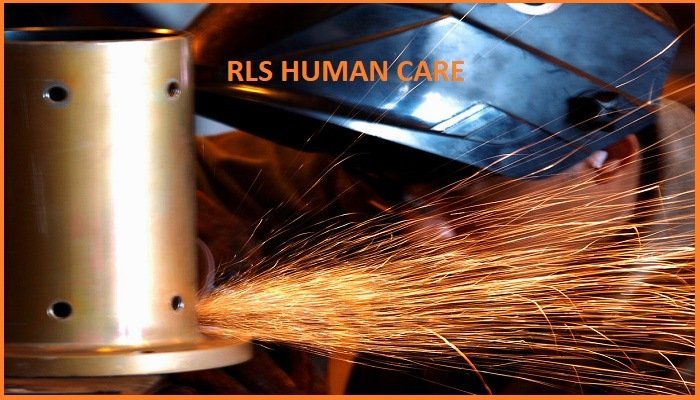Classification uses and safety aspects of machine tools are important.
Contents
Definition and Classification of Machine Tools:
A Machine Tool is a machine for making articles of a given shape, size, and accuracy (according to the blueprints) by removing metal from workpieces. Machine tools are factory equipment for producing machines, instruments and tools of all kinds.
Machine tools are classified as:
- Lathes
- Drilling and boring machines
- Grinding, Polishing or Finishing machines
- Combination machine tools
- Gear and Thread cutting machines
- Milling machines
- Planning, Shaping, Slotting and Broaching machines
- Cutting off machines
- Miscellaneous machine.
Safety in the use of Machine Tools
Machine wise hazards and guards are explained below.
Turning Machine (Lathe)
Turning consists in shaping a rotating piece by revolving it against a cutting tool, thus producing a cylindrical surface. Machine tools coming under this category include all forms of metal turning lathes including automatic screw machines.
Some hazards and suitable machine guards are as follows:
| Hazards | Guards/Controls | |
| 1. | Contact with projections of faceplates and chucks. | Head-stock guard. Chuck guard. |
| 2. | Contact with projections of the dogs and projecting set screws. | Countersunk screws. |
| 3. | Flying metal chips, long burrs, and turnings. | Enclosure guard, portable perspex screen guard, use of chip breaker tool. |
| 4. | Hand braking of machines. | Foot pedal brake with trip switch, pneumatic chuck and feeding tools for small jobs. |
| 5. | Filling and emerying without a holding device. | Automatic emerying. Emery holder. |
| 6. | Gauging the job while the machine is in motion. | Dial indicators. Tight-fitting clothing. |
| 7. | Cleaning chips in motion. | Safety hook/brush. |
| 8. | Projection of the work or stock beyond the machine. | Tube guard. Bar stock guard. |
| 9. | Flying off the job. | Full enclosure guard. |
| 10. | Inserting blanks and removing the processed part without stopping. | Spindle jaws, mechanical feeding device, and safety fixture. |
| 11. | The splashing of coolant resulting in slipping hazards and dermatitis. | Splash guard, pan and enclosure guard mounted on rollers. Floor mats. |
| 12. | Flying chips of cast iron, brass, and other non-ferrous metals. | Chip guard. Goggles or face shield. |
| 13. | Pulleys, belts, gears, setscrews. | Fixed guards. Hinged guard. |
Turrets & Capstan Lathes:
| 14. | Counter-weight falling and bar flying through turret head. | Tube guard. Blank off the hole. |
Multispindle Lathe:
| 15. | Collecting component while just parting off. | Wire mesh. Spoon collectors. |
| 16. | The parted component comes in-between tool and the first spindle. | Sharpening tools properly. |
Boring or Drilling Machines
Boring or drilling consists of cutting a round hole by means of a rotating cutting tool. Machines in this class are vertical or horizontal, fixed or portable drills, reamers, honers.
Some hazards and guards are as follows:
| Hazards | Guards/Controls | |
| 1. | Spindle contact. | Sleeve guard. |
| 2. | Tool and chuck. | Telescopic drill guard, combined drill & chuck guard. |
| 3. | Unclamped job and breakage of tool or struck by the job. | Clamp the job. Use the iron plate (L section) for a big job. |
| 4. | Hair and loose clothing in contact with revolving spindle and bit. | Cage type guard. Cap. Tight-fitting clothing. Gloves, neckties long sleeves not permissible. |
| 5. | Sweeping chips by hand. | Brush. |
| 6. | Belts, pulley, gears, setscrew. | Fixed guards. |
| 7. | Flying particles. | Barrier guard. Goggles. |
| 8. | Rotating horizontal table. | Surrounding machine guard. |
Milling Machines
Milling consists of machining a piece of metal by bringing it into contact with a rotating cutter with multiple cutting edges. Machines in this class are vertical or horizontal milling machines, planer-type milling machines, gear robbers and special machines using one or more milling cutters with other tools. According to one survey @ 66% of all milling machine, accidents occur when operators load, unload or make adjustments while machine in motion.
Some hazards and guards are as follows:
| Hazards | Guards/Controls | |
| 1. | Revolving cutter. | Jaw type interlocked or adjustable guard or a self-closing guard which automatically close when the job table moves backward and opens when it moves forward for operation. The guard may be transparent if visibility is required. |
| 2. | Removing chips and swarf cleaning by hand and using rag to clean oil while it is running. | Brush, magnetic sweep, cleaning after stopping the machine. Long sleeves to be avoided. |
| 3. | Failure to clamp the work properly. | Permanent magnetic plate fitted on the bed. |
| 4. | Failure to draw the job back to a safe distance while loading or unloading. | Fixed guard. |
| 5. | Tightening or loosening arbor nut and other parts. | Use proper spanners. Education and training. |
| 6. | Power drive pulley, belts, gears etc. | Closed housing or fixed guards and start/stop switch within reach. |
Planning & Shaping Machine
Planing consists of machining a surface by moving the work (job on the bed) back and forth under a stationary cutting tool. In shaping the work is held stationary under a reciprocating tool. Machines in this class include planers, shapers, broachers, slotters, and key seaters.
Some hazards and guards are as follows:
| Hazards | Guards/Controls | |
| 1. | Bed traveling within a short distance from a fixed object. | Fixed guard or fencing to prevent entrapping within 45 cm (section 25, F.A) All gaps to be guarded. |
| 2. | Falling material from the table or bed. | Fixed or self-adjusting table guards on sides. Job clamping device. |
| 3. | Pully, belts, drives and reversing dogs. | Fixed guards, starting and stopping device. |
| 4. | Flying particles. | Aprons, goggles side runway for large planers. |
| Shapers: | ||
| 1. | Speed changing and other drives. | Fixed or hinged guards. |
| 2. | Flying and removing chips. | Aprons, Goggles, brush. |
| 3. | Flying jobs. | Clamping device. |
| 4. | Moving ram and tool. | Transparent shield for tool. A retriever to the limit of the stroke of ram channel. |
| 5. | Reversing dogs. | Fixed guard. |
| 6. | Other as for planners. | As for planners and stated above. |
Broaching Machines
Slotting Machine
Slotting machine is like a shaping machine. The tool may work vertically or horizontally. Hazards and controls are similar to that of shaping machine.
Grinding Machine
Grinding consists of shaping metal by bringing it into contact with a rotating abrasive wheel. Grinding may be internal or external, flat, cylindrical or centerless. Polishing, Buffing, honing and lapping are also considered as parts of the grinding process.
Main causes of accidents are wheel breakage due to hidden or undetected cracks, mechanical shock, over or loose tightening, the unchecked traverse of the work on the side of the wheel, over speeding, incorrect selection of wheel, excessive heating, excessive work pressure and eye or face injury due to flying particles.
Some hazards and guards are as follows:
| Hazards | Guards/Controls | |
| 1. | Flying particles, Coolant, and lubricants. | Goggles or face shield. Eyeshield attached with the machine frame. |
| 2. | Dust generation. | Local exhaust ventilation. |
| 3. | Bursting of the wheel. | Protection hood (Wheel guard) and protection of flanges. Chucks or bands. No over speeding. Avoid grinding on the side of the wheel. Compliance of sec. 30, Factories Act. |
| 4. | Accidental contact with the running wheel. | Tool or work rest and its proper adjustment to avoid contact and trapping. |
| 5. | Portable grinders. | Wheel guard. Electrically earthed and fully safe. Shock-proof gloves. |
| 6. | Belt drive and other dangerous parts. | Fixed guard. |
Main precautionary measures are as under
- Selection of a right wheel for right speed and right diameter. With the same rpm, the peripheral speed increases as wheel diameter increases and centrifugal force increase as peripheral speed increases. Due to excessive centrifugal force, the wheel may break. Therefore peripheral speed (m/s or f/m) is most important and a grinding wheel should be selected based on its peripheral speed.
- The ring test is carried out by a qualified person to check any crack in the wheel.
- Speed test before installing the wheel. Test speed should be 1.5 × service speed. Testing should be on special stands.
- The wheel should never be rotated at a higher speed than that stamped on it.
- Wheel guard (hood) should be fastened securely to the grinding head to protect against flying fragments or coolant if any. An adjustable tongue or a movable wheel guard is necessary to restrict wheel exposure to 6 mm.
- Abrasive dust and slurry removal equipment should be in good repair. Dust generating equipment should be in a separate room.
- Electrical earthing, bonding and on-off switch in easy reach.
- Proper storing in dry area. Use special racks, shelves or boxes according to the shape & size Proper dressing of the wheel.
- Proper dressing of the wheel.
- Use wheel washer and flanges of the correct size and equal diameter (at least 1/3 dia of the wheel).
- Avoid overtightening or loose tightening. Use the proper tool. Proper mounting to avoid internal stress. Use mounting blotters supplied with wheels.
- Check spindle threads so that the nut is not loosened on revolution.
- Use spindle of the correct diameter.
- Balance the wheel to avoid vibration. Balance before installation.
- Apply for the work slowly and gently. Do regular lubrication.
- Avoid side grinding, over speed and cleaning, adjusting or gauging while the machine is in motion.
- Wheel exceeding dia 15 cm or speed 50 m/s should have a strength-test mark.
- Adjust tool rest properly.
Top 75 Health and Safety Blogs and Websites on the Web











I Worked as a Safety officer 16 (sixteen) Years in Gulf & India and also Approved Saudi Aramco safety officer. Furthermore, worked as a Fire safety expert (Supervisor) in Project / Building /Constriction & Hydrocarbon Plant with around 16 years as safety officer